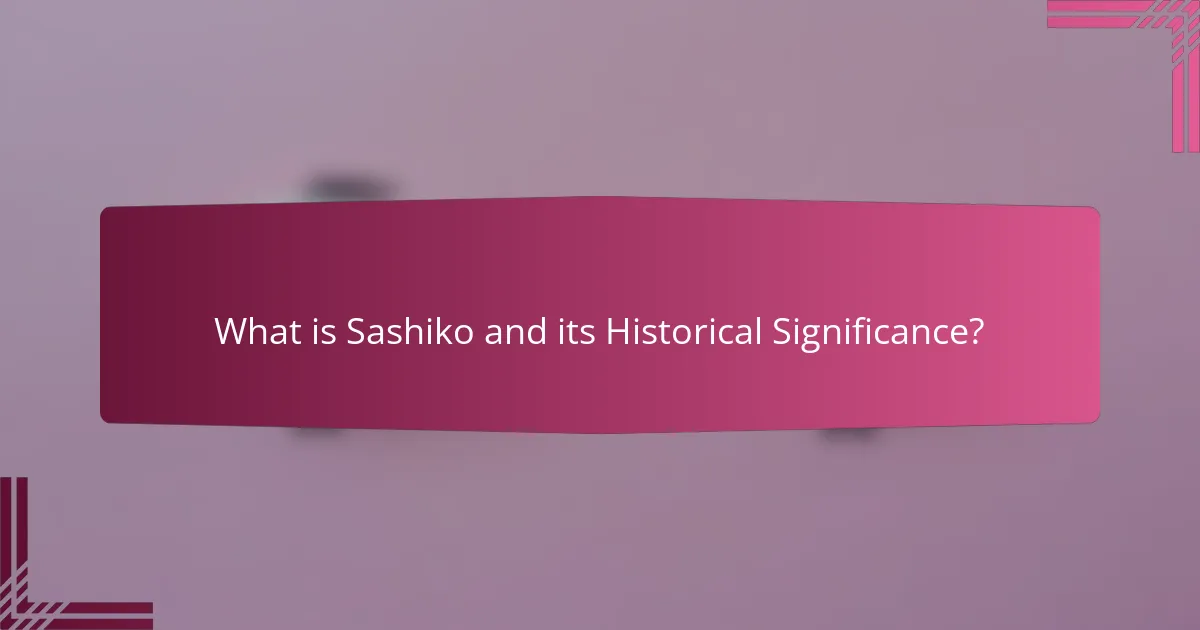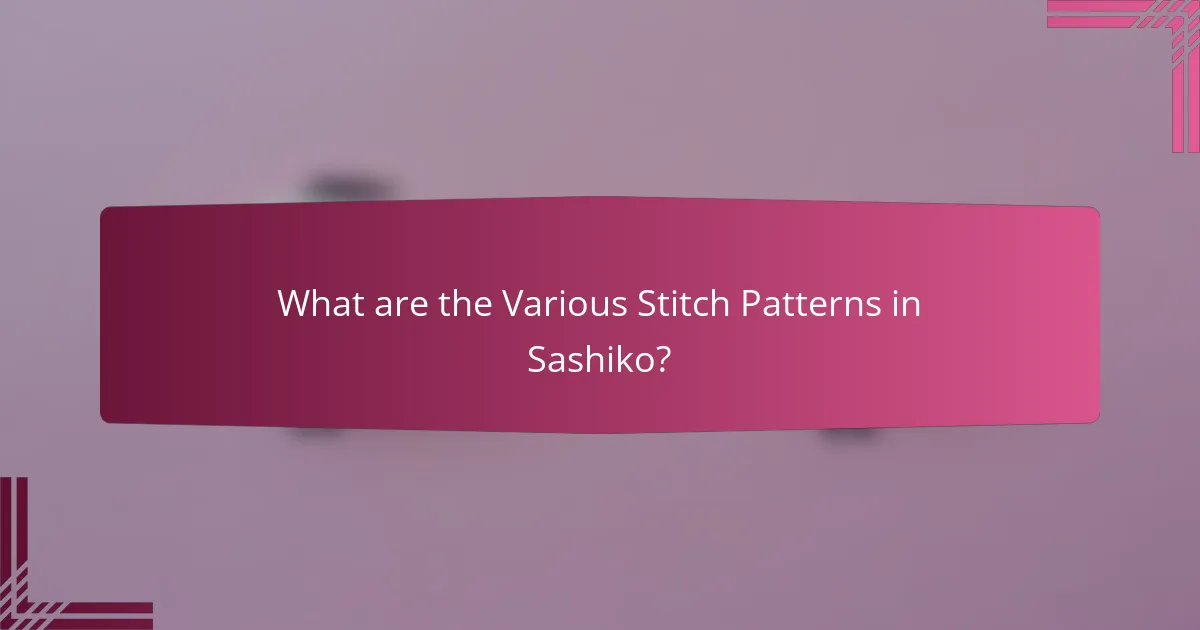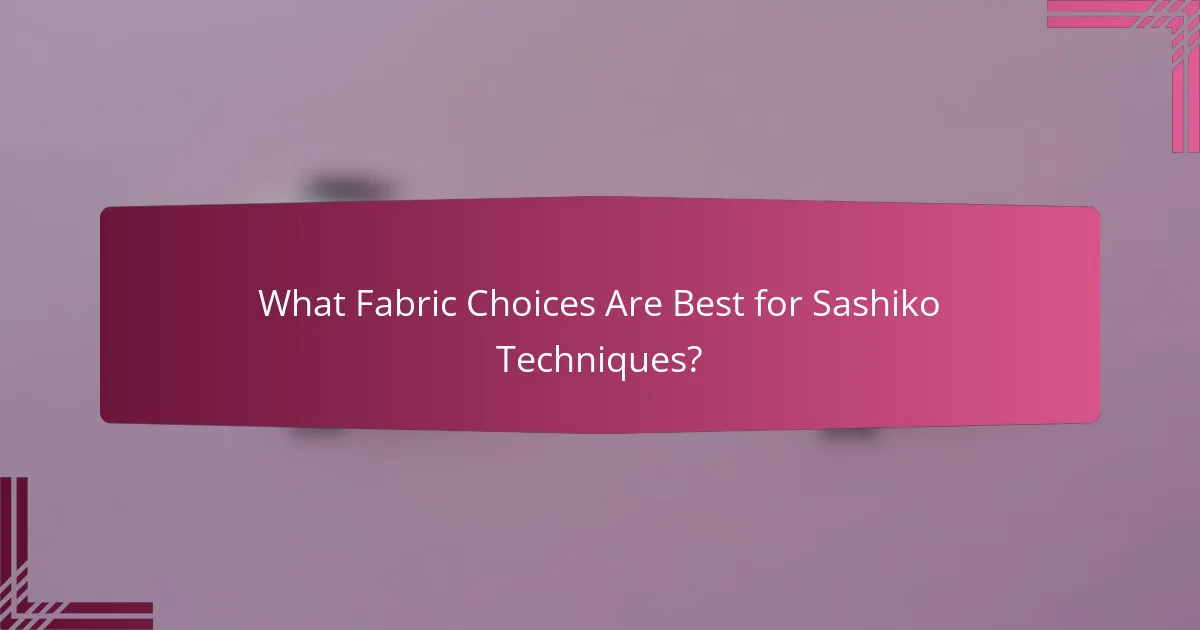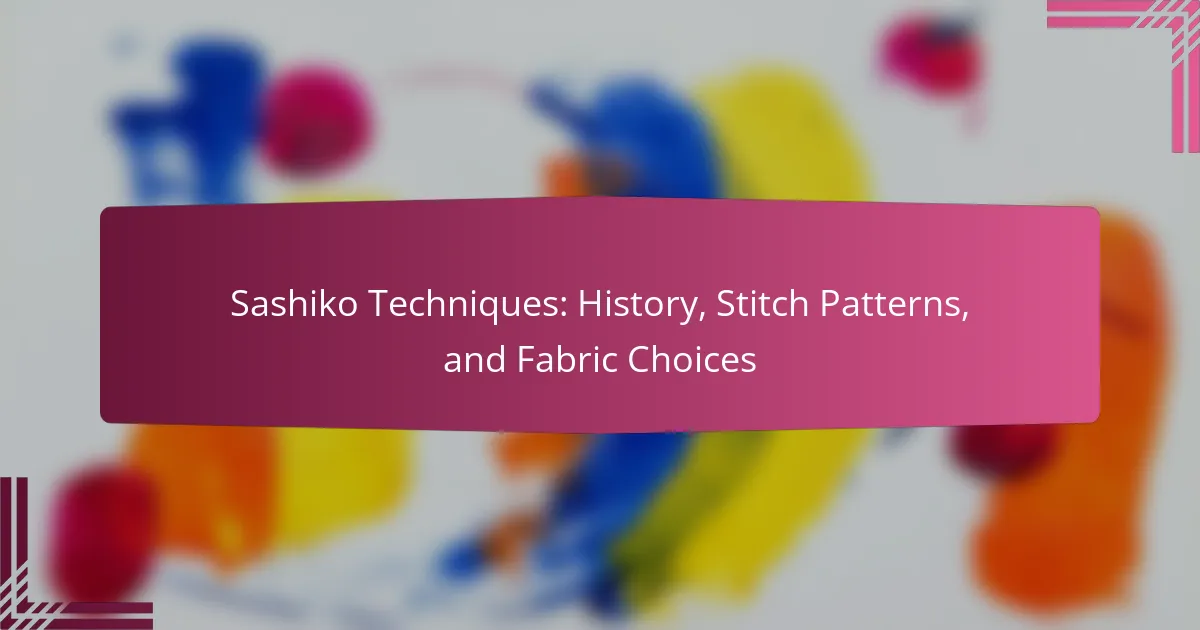
What is Sashiko and its Historical Significance?
Sashiko is a traditional Japanese stitching technique used for decorative and functional purposes. It originated in the Edo period (1603-1868) as a way for rural communities to reinforce and repair garments. Sashiko translates to “little stabs,” referring to the small, running stitches used in the technique. Historically, it was practiced by the working class, who valued practicality and durability in clothing. Over time, Sashiko evolved into an art form, showcasing intricate patterns and designs. It reflects the Japanese aesthetic of wabi-sabi, emphasizing beauty in imperfection and transience. Today, Sashiko is celebrated for its cultural significance and is used in various textile arts worldwide.
How did Sashiko originate in Japan?
Sashiko originated in Japan as a practical technique for reinforcing and mending clothing. It emerged during the Edo period, around the 17th century. Farmers and laborers utilized Sashiko to extend the life of their garments. The technique involved simple running stitches, creating geometric patterns. These patterns were not only functional but also evolved into decorative art. Sashiko reflects the resourcefulness of Japanese culture in using available materials. Historical records indicate that it was often used in rural areas for utilitarian purposes. Over time, Sashiko gained popularity and became an integral part of Japanese textile art.
What cultural factors influenced the development of Sashiko?
Sashiko developed as a practical form of embroidery in Japan. It originated from the need for durable clothing among the working class. The Edo period (1603-1868) saw an increase in textile production and the use of indigo-dyed fabric. This period emphasized frugality and resourcefulness, leading to the embellishment of worn garments. Sashiko stitching provided reinforcement to fabric, extending the life of clothing. Additionally, the aesthetic appeal of geometric patterns reflected Japanese cultural values of simplicity and harmony. The influence of Zen Buddhism also contributed to the appreciation of minimalism in design.
How has Sashiko evolved over the centuries?
Sashiko has evolved significantly over the centuries. Originally, it began as a practical method for mending and reinforcing garments in rural Japan during the Edo period. The technique utilized simple running stitches to create durable fabric. Over time, it transformed into a decorative art form, incorporating intricate patterns and designs. By the 20th century, Sashiko gained international recognition as a unique craft. Today, it is celebrated for its aesthetic appeal and cultural significance. Various styles and modern interpretations have emerged, blending traditional techniques with contemporary fashion. The evolution reflects changes in societal values and artistic expression.
What are the key characteristics of Sashiko techniques?
Sashiko techniques are characterized by their distinctive running stitches and geometric patterns. These stitches are typically made with white thread on indigo fabric. The technique originated in Japan as a method of reinforcing and mending clothing. Sashiko is often associated with a philosophy of simplicity and functionality. The patterns can range from simple lines to complex designs. Each stitch is usually spaced evenly, creating a rhythmic appearance. Sashiko also emphasizes the use of natural materials. This approach reflects a deep connection to Japanese culture and craftsmanship.
What types of stitches are used in Sashiko?
Sashiko uses several types of stitches, primarily including the running stitch. The running stitch is characterized by a simple, continuous line of stitches. Another common stitch is the cross stitch, which forms an ‘X’ shape. The back stitch is also utilized, providing a solid line that reinforces the design. Additionally, the whip stitch is sometimes used for decorative edges. These stitches can be combined for intricate patterns. Sashiko stitches are typically done with white thread on indigo fabric, enhancing visibility. This traditional technique originated in Japan and has historical significance in mending and embellishing textiles.
How do Sashiko stitches differ from traditional embroidery stitches?
Sashiko stitches differ from traditional embroidery stitches in their purpose and technique. Sashiko is a Japanese form of decorative reinforcement stitching. It emphasizes functional stitching, often used to strengthen fabric. Traditional embroidery focuses more on decorative elements without necessarily reinforcing the fabric. Sashiko stitches typically feature a repetitive geometric pattern. In contrast, traditional embroidery can involve a variety of designs, including floral or intricate motifs. The thread used in Sashiko is usually thicker, creating a more pronounced texture. Traditional embroidery often uses finer threads for detailed designs. Sashiko stitches are generally executed in a straight line, while traditional embroidery employs various stitch types. This distinction highlights Sashiko’s unique cultural heritage and practical application in textile arts.
Why is Sashiko considered a sustainable practice?
Sashiko is considered a sustainable practice because it promotes the repair and reuse of textiles. This technique originated in Japan as a method to reinforce and extend the life of fabric. Sashiko utilizes simple stitches to mend and decorate worn clothing, reducing waste. By focusing on upcycling, it minimizes the need for new materials. The practice encourages a mindset of valuing and preserving resources. Historical context shows that Sashiko was used by rural communities to maintain garments over generations. This tradition aligns with modern sustainable practices by emphasizing longevity and resourcefulness in fashion.
How does Sashiko contribute to textile recycling?
Sashiko contributes to textile recycling by promoting the repair and repurposing of damaged fabrics. This traditional Japanese stitching technique reinforces worn areas, extending the life of textiles. Sashiko encourages creativity by transforming old garments into unique, functional pieces. The practice reduces waste by preventing textiles from ending up in landfills. Historical evidence shows that Sashiko originated as a practical method for mending clothing among the working class. By revitalizing old fabric, Sashiko fosters a sustainable approach to fashion. This method aligns with modern recycling efforts by emphasizing the value of upcycling. Overall, Sashiko serves as a cultural and practical solution to textile waste.
What are the environmental benefits of using Sashiko techniques?
Sashiko techniques offer significant environmental benefits by promoting sustainable practices in textile use. This method emphasizes the repair and reuse of fabrics, reducing textile waste. Sashiko encourages the use of natural materials, which are biodegradable and less harmful to the environment. The techniques often utilize leftover fabric scraps, minimizing the need for new materials. By extending the life of garments, Sashiko helps decrease the demand for fast fashion. Additionally, the focus on hand-stitching reduces reliance on energy-intensive machinery. Overall, Sashiko fosters a culture of sustainability in the textile industry.

What are the Various Stitch Patterns in Sashiko?
Sashiko features various distinct stitch patterns. Common patterns include the “Asanoha” (hemp leaf) and “Kikkō” (tortoise shell). Other patterns are “Seigaiha” (blue ocean waves) and “Yagasuri” (arrow feathers). Each pattern has unique geometric shapes and meanings. Asanoha symbolizes growth and resilience. Kikkō represents longevity and protection. Seigaiha signifies peace and happiness. Yagasuri conveys strength and direction. These patterns are traditionally used in Japanese textiles. Sashiko patterns often enhance the aesthetic and functional qualities of fabric.
What are the most popular Sashiko stitch patterns?
The most popular Sashiko stitch patterns include Asanoha, Seigaiha, and Kikkō. Asanoha features a geometric design resembling hemp leaves. Seigaiha consists of overlapping semicircles, symbolizing waves. Kikkō represents a tortoise shell pattern, symbolizing longevity. Other notable patterns are Tachiwaki, which resembles vertical lines, and Shippō, representing interconnected circles. These patterns have historical significance in Japanese culture and are commonly used in traditional textiles. Each pattern showcases unique aesthetics and craftsmanship associated with Sashiko embroidery.
How do geometric patterns play a role in Sashiko design?
Geometric patterns are fundamental to Sashiko design. They serve as the basis for the visual aesthetics of this traditional Japanese embroidery technique. Sashiko patterns often include shapes like squares, diamonds, and hexagons. These shapes create a rhythmic and harmonious appearance in the fabric.
The use of geometric patterns in Sashiko also has practical origins. Historically, they were used to reinforce fabric and extend the life of clothing. The repetition of shapes allows for consistent stitching, which enhances durability.
Additionally, geometric designs symbolize various meanings in Japanese culture. For example, certain patterns represent prosperity and longevity. This cultural significance adds depth to the visual appeal of Sashiko.
Overall, geometric patterns are essential for both the decorative and functional aspects of Sashiko design. They embody a blend of artistry and utility that characterizes this unique craft.
What are some examples of traditional Sashiko motifs?
Traditional Sashiko motifs include Seigaiha, Asanoha, and Kikkō. Seigaiha features waves and symbolizes peace and good luck. Asanoha resembles hemp leaves and represents growth and resilience. Kikkō is a hexagonal pattern that signifies longevity and good fortune. These motifs have historical significance in Japanese culture and are often used in textiles. Each design carries unique meanings and reflects the artistry of Sashiko stitching.
How can one create custom Sashiko patterns?
To create custom Sashiko patterns, start by sketching your design on paper. Use geometric shapes or nature-inspired motifs for inspiration. Next, transfer the design onto fabric using a fabric marker or chalk. Ensure the design is clear and visible for stitching. Choose a suitable thread color that contrasts with the fabric. Typically, white or cream thread is used on indigo fabric. Begin stitching using the traditional Sashiko technique, which involves a simple running stitch. Maintain consistent spacing between stitches for a uniform look. Adjust the pattern as needed during stitching to enhance the design. Custom patterns can reflect personal style and creativity, making each piece unique.
What tools and materials are needed for designing Sashiko patterns?
To design Sashiko patterns, essential tools and materials include fabric, Sashiko thread, a Sashiko needle, and a marking tool. Fabric should ideally be cotton or a similar sturdy material to support the stitching. Sashiko thread, which is thicker than regular sewing thread, provides durability and visibility. A Sashiko needle is longer and has a larger eye to accommodate the thicker thread. A marking tool, such as a water-soluble pen or chalk, is necessary for transferring patterns onto the fabric. These components are crucial for achieving the traditional Sashiko aesthetic and functionality.
What steps should be followed to develop a unique Sashiko design?
To develop a unique Sashiko design, start by selecting a theme or inspiration. This could be nature, geometric shapes, or personal experiences. Next, sketch your design on paper. Use simple shapes and lines to visualize the pattern. Choose your fabric carefully, as the texture and color will affect the final look. Select appropriate thread that contrasts well with the fabric. Transfer your design onto the fabric using a water-soluble pen. Begin stitching using traditional Sashiko techniques, ensuring even spacing and tension. Regularly step back to assess the design’s overall appearance. Adjust as needed to maintain balance and harmony in the pattern.

What Fabric Choices Are Best for Sashiko Techniques?
Cotton fabrics are the best choices for Sashiko techniques. They provide durability and ease of stitching. Fabrics like cotton canvas and quilting cotton are particularly favored. These materials hold up well under repetitive stitching. Additionally, they allow for clear visibility of the thread patterns. Lightweight cotton is also suitable for intricate designs. The fabric’s tight weave supports precise stitching without fraying. Historical practices often used indigo-dyed cotton, which adds aesthetic appeal.
What types of fabrics are suitable for Sashiko stitching?
Cotton and linen are the most suitable fabrics for Sashiko stitching. These materials are durable and provide a stable base for the intricate stitching. Cotton is widely preferred due to its availability and ease of handling. Linen, while less common, offers a unique texture that enhances the visual appeal of Sashiko designs. Both fabrics can withstand the tension of stitching without fraying. Additionally, medium to heavy-weight fabrics work best to support the embroidery. Fabrics with a tight weave help maintain the integrity of the stitches. Overall, the choice of fabric influences the final appearance and durability of the Sashiko work.
How does fabric weight impact the Sashiko stitching process?
Fabric weight significantly impacts the Sashiko stitching process. Heavier fabrics provide more stability during stitching. This stability allows for more precise and consistent stitches. Lighter fabrics may shift more easily, leading to uneven stitching. Additionally, heavy fabrics can better support the tension required for Sashiko patterns. The type of fabric also influences needle choice and thread thickness. A thicker thread is often used with heavier fabrics, enhancing the visual effect of the stitching. Conversely, lighter fabrics may require finer threads for a delicate appearance. Ultimately, the weight of the fabric affects the overall effectiveness and aesthetic of Sashiko stitching.
What are the benefits of using cotton versus other fabrics for Sashiko?
Cotton offers several benefits for Sashiko compared to other fabrics. It is durable and withstands the repetitive stitching involved in Sashiko techniques. Cotton fibers have a natural breathability, allowing for comfortable wear. This fabric absorbs dye well, resulting in vibrant colors that enhance the visual appeal of Sashiko designs. Additionally, cotton is readily available and affordable, making it accessible for various projects. Unlike synthetic fabrics, cotton is easy to work with and provides a traditional aesthetic that aligns with Sashiko’s historical roots. These attributes make cotton the preferred choice for Sashiko practitioners.
How do fabric colors and patterns affect Sashiko designs?
Fabric colors and patterns significantly influence Sashiko designs. The choice of color affects the visibility and contrast of the stitching. Dark fabrics highlight white or light thread, creating striking designs. Conversely, light fabrics with dark thread produce subtle, elegant patterns. Patterns on fabric can also dictate the complexity of Sashiko designs. Simple patterns allow for intricate stitching, while busy patterns may require more straightforward designs to maintain clarity. Historical practices show that traditional Sashiko often utilized indigo-dyed fabrics, which enhanced the aesthetic of the white stitches. These color and pattern choices contribute to the overall visual impact and cultural significance of Sashiko.
What color combinations work best for Sashiko projects?
Traditional Sashiko projects often use a combination of indigo blue fabric with white thread. This classic pairing creates a striking contrast that highlights the intricate stitching. Other effective color combinations include black fabric with white or light-colored thread. This option provides a modern twist while maintaining the traditional aesthetic. Additionally, earthy tones like brown or beige can be paired with muted thread colors for a more subtle appearance. Using complementary colors can also enhance the visual appeal of Sashiko designs. Choosing colors that resonate with the theme of the project is essential for achieving the desired effect.
How can patterned fabrics enhance Sashiko stitching?
Patterned fabrics can enhance Sashiko stitching by providing visual contrast that highlights the stitch work. The intricate designs on the fabric can complement the geometric patterns typically used in Sashiko. This creates a dynamic interplay between the fabric and the stitching. Additionally, using patterned fabrics can add depth and interest to the overall piece. The colors and motifs of the fabric can influence the aesthetic outcome of the Sashiko design. Furthermore, contrasting patterns can draw attention to the craftsmanship of the stitching. This technique allows for creative expression and personalization in Sashiko projects. Overall, patterned fabrics serve as a canvas that elevates the beauty of Sashiko stitching.
What tips can help beginners succeed in Sashiko techniques?
Start with simple patterns to build confidence. Beginners should practice basic stitches like the running stitch. Use quality fabric that can withstand repeated stitching. Cotton fabric is ideal for Sashiko. Invest in proper tools, including Sashiko needles and thread. Sashiko thread is thicker than regular sewing thread. Take your time to ensure even stitches and spacing. Consistency in stitch size enhances the overall look. Lastly, watch instructional videos for visual guidance. These tips will help beginners achieve success in Sashiko techniques.
What common mistakes should beginners avoid in Sashiko stitching?
Common mistakes beginners should avoid in Sashiko stitching include inconsistent stitch length. Maintaining uniformity in stitch length is crucial for a neat appearance. Beginners often skip practicing on scrap fabric, which can lead to errors. Not using the right needle can also cause difficulties. A Sashiko needle is longer and thicker than regular sewing needles. Beginners may forget to pre-wash their fabric, leading to shrinkage after stitching. Additionally, neglecting to mark the stitching lines can result in misalignment. Over-tightening stitches is another frequent issue that can distort the fabric. Lastly, beginners often underestimate the importance of using appropriate thread, such as Sashiko thread, for optimal results.
How can one improve their Sashiko stitching skills over time?
To improve Sashiko stitching skills over time, practice consistently and focus on technique. Regular practice helps reinforce muscle memory and enhances precision. Start with simple patterns before progressing to more complex designs. This gradual approach builds confidence and skill level. Additionally, studying traditional Sashiko techniques and patterns can provide valuable insights. Resources such as books and online tutorials offer structured guidance. Joining a Sashiko community or taking classes can provide feedback and support. Engaging with experienced practitioners fosters learning and inspiration. Lastly, experimenting with different fabrics and threads can enhance creativity and adaptability in stitching.
Sashiko is a traditional Japanese stitching technique that originated in the Edo period, primarily used for reinforcing and mending garments. This article explores Sashiko’s historical significance, its evolution into an art form, and the cultural factors that influenced its development. Key characteristics of Sashiko techniques, including various stitch types and popular geometric patterns, are outlined, along with fabric choices that enhance the stitching process. Additionally, the article discusses the sustainability of Sashiko practices, offering tips for beginners and insights into creating custom designs.
